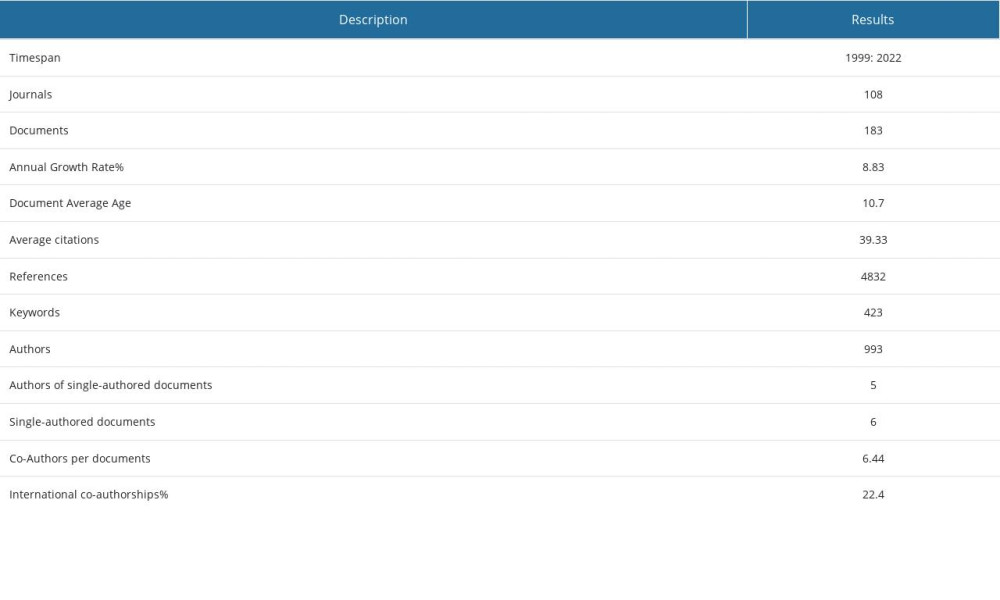06 June 2023: Database Analysis
Quantitative Review of Anesthesia in Liver Tumor Ablation: A Bibliometric Study from 1999 to 2022
Ying-Dong Qu1BCDEF, Zhen Chen1BCDE, Xiang Li1ABCDEF*DOI: 10.12659/MSM.939607
Med Sci Monit 2023; 29:e939607
Abstract
BACKGROUND: Ablation has been developed as a radical surgical procedure for liver tumors. Local anesthesia in combination with general anesthesia or intravenous sedation is needed in ablative procedures. Although many studies have been published, a related bibliometric study is lacking. The present bibliometric analysis aimed to further understand the current situation of anesthesia for liver tumor ablation and discover candidate novel research directions.
MATERIAL AND METHODS: Web of Science Core Collection (WoSCC) was searched to identify studies associated with anesthesia for liver tumor ablation. Also, countries, journals, authors, and institutes contribution together with co-occurrence relations were analyzed by R, VOSviewer, and CiteSpace software; meanwhile, relevant research hotspots together with potential future trends were identified.
RESULTS: This work obtained 183 English-language documents during 1999-2022, and the annual growth rate was 8.83%. Most studies were conducted in the United States (24.04%, 44/183). The Oslo Univ Hosp contributed the most publications (n=11, 6.01%). Livraghi T (n=6), De Baere T (n=5), and Goldberg SN (n=4) ranked top in terms of cited authors and top authors. Keywords from that co-cited network were aggregated and identified, which revealed a shift in the liver tumor ablation anesthesia field. Initially, hotspots were predominantly “alcohol injection”, “radiofrequency tissue ablation”, and “metastases”, but hotspots shifted to “efficacy”, “ablation”, “pain”, “microwave ablation”, “management”, “analgesia”, “safety”, “irreversible electroporation”, and “anesthesia” recently.
CONCLUSIONS: Anesthesia has received increased attention as liver tumor ablation advances. Bibliometric study findings provide insight into the current state and trends of anesthesia in liver tumor ablation research.
Keywords: Ablation Techniques, Anesthesia, Bibliometrics, Liver, Humans, Anesthesia, General, Anesthesiology, Liver Neoplasms, Pain
Background
Liver tumor ranks the fourth and third places among cancers worldwide in terms of its morbidity and mortality, respectively [1]. Currently, major curative treatments are surgical liver transplantation, resection, and ablation [2]; however, many patients have distant metastasis, lymphatic metastasis, and cirrhosis at the time of diagnosis. Consequently, 70% of such patients cannot receive radical surgical treatment. For patients without the possibility of radical resection, interventional ablation treatment has been gradually recognized as the most potent treatment modality [3]. Ablation creates a small trauma, which can cure some cases and thus provide a chance of radical treatment for inoperable cases [4]. It was reported that comparable overall survival was observed between local ablation and surgical resection for patients with the Milan criteria [5].
Ablation is a kind of radical treatment commonly applied in the clinic and requires local anesthesia in combination with general anesthesia or intravenous sedation [6]. Generally, the anesthesia option for liver ablation depends on the planned approach. Specifically, compared with the percutaneous approach that is conducted under monitored anesthesia care and local infiltration, general anesthesia is needed in the laparoscopic approach. Generally, a laparoscopic approach is especially suitable for treating lesions that can hardly be targeted by percutaneous puncture. Under some circumstances, general anesthesia is needed in liver ablation [7].
In the past several decades, a growing number of articles concerning anesthesia for liver ablation have been published. However, a study comprehensively assessing those relevant publications is lacking. Bibliometrics utilizes statistical and mathematical approaches for the quantitative analysis of numerous studies in a single specific research field, revealing diverse facets as well as research trends in the specific field. Currently, scientometric analysis on relevant studies is mainly conducted based on CiteSpace [8], VOSviewer [9], and R package “bibliometrix” [10]. Scientometric analysis is adopted by many researchers for assessing corresponding research domains [11]. However, scientometric analysis concerning data on anesthesia mapping in liver ablation is currently lacking.
This work aimed to assess studies associated with anesthesia in liver ablation between the years 1999 and 2022 for depicting the current situation in this field and identifying novel research directions.
Material and Methods
DATA SOURCE:
The Web of Science Core Collection (WoSCC) database was searched to obtain data through October 31, 2022, by 2 authors independently. Search terms included “liver”, “ablation”, and “anesthesia”. Baseline data were collected from eligible articles, including authors, title, abstract, institution, journal, country/region, keywords, and references. Eligible articles from the database were included, but those with the following criteria were excluded: data papers, book chapters, proceedings papers, meeting abstracts, duplicates, editorials, or non-published articles with insufficient data available. Divergent viewpoints were resolved through consulting a senior physician. As this study was based solely on literature, obtaining informed consent or approval from the institutional review board was waived.
TOOLS FOR BIBLIOMETRIC ANALYSIS:
Publication traits were depicted in this work, including institute, country, journals, and keywords. The H-index represents a critical factor that can be used for reflecting scientific research value [12]. The basic analysis was conducted using R package “bibliometrix” (http://bibliometric.com/). VOSviewer (1.6.18) was used to explore collaboration networks between authors, institutes, countries, and keywords [13]. CiteSpace can extract keywords and references from publications with high citation bursts and construct a dual-map overlay for journals [14]. Therefore, reference citation analysis was carried out in CiteSpace (5.7.R5), along with construction of knowledge maps and identification of burst keywords for generating the novel recurrent keywords.
Results
ANNUAL PUBLICATION AND COOPERATION:
As revealed by the literature collection, studies regarding anesthesia for liver ablation were first published in 1999, and a total of 183 published documents about this topic were acquired by searching the WoSCC database (Figure 1A, Table 1). By fitting data using the line model, we observed a steady increasing annual output, with a growth rate of 8.83%. The United States was the most active cooperative country for publications in the country collaboration map (Figure 1B).
COUNTRIES AND INSTITUTIONS:
In total, 183 documents were published in 36 countries. In line with the publication number displayed in the bar graph (Figure 2A), the 3 most significant countries included United States (24.04%, 44/183), China (13.66%, 25/183), and Germany (9.29%, 17/183). Additionally, Figure 2B displays the close coordination among countries, particularly between China and the United States. The nodes in the graph indicate countries, circle size indicates the number of documents published in that country, and the circles with connecting lines indicate the co-occurrence relations among countries.
A total of 248 institutions contributed to the above studies, among which the 10 most significant institutions contributed to a total of 74 documents, constituting 40.44% of the entire production (Figure 2C). Oslo Univ Hosp, Univ Wisconsin, and Nanjing Med Univ were the top 3 institutions. Oslo Univ Hosp ranked first (n=11, 6.01%), followed by Univ Wisconsin (n=10, 5.46%) and Nanjing Med Univ (n=7, 3.82%). As shown in Figure 2D, the United States displayed the widest inter-agency cooperation, and Beth Israel Deaconess Med Ctr had close cooperation with numerous research institutions and universities.
AUTHORS:
In total, there were 993 authors participating in liver ablation anesthesia-associated studies. Co-authorship was analyzed among authors by VOSviewer (Figure 3A). As a result, a tight co-occurrence relation among authors was detected, with more prolific authors often co-occurring more with others. Author productivity through Lotka’s law showed that most authors authored ≤2 documents (85.5% and 96.8% authored 1 and ≤2 documents, respectively, Figure 3B). Of them, the 3 authors who published the most articles were Livraghi T (n=6), De Baere T (n=5), and Goldberg SN (n=4). In Figure 3C, showing authors’ production over time, Solbiati L had the longest timeline from 2000 to 2020. Among the top impact authors measured using the H-index (Figure 3D), Livraghi T (n=6), De Baere T (n=5), and Goldberg SN (n=4) ranked in the top 3 places.
JOURNALS:
In total, 108 academic journals on this topic were published with 4 main clusters: radiology, medical physics, surgery, and anesthesia (Figure 4A). Diverse journals exhibited positive citation relations. Among these 4 clusters, the radiology cluster had the top 3 number of documents and highest H-index impact (Figure 4B, 4C), with the Journal of Vascular and Interventional Radiology (JVIR, n=11 and 9, respectively) ranking first, followed by Radiology (n=10 and 8, respectively) and Cardiovascular and Interventional Radiology (CVIR, n=9 and 7, respectively). As shown in the journal dual-map overlay in Figure 4D, journal topic distribution was presented. Citing and cited journals were located on the left and right of the map, respectively. Labels stood for journals-covered disciplines. Colored lines from left to right describe citation paths, with a green path suggesting the frequent citation of studies published in medical/medicine/clinical journals from those published in health/nursing/medicine journals.
KEYWORDS:
By keyword co-occurrence analysis, research hotspots were rapidly captured in 1 specific field. Figure 5A presents the 20 most frequent keywords occurring in this work. Among these keywords, “radiofrequency ablation” and “hepatocellular carcinoma” occurred over 20 times, indicating the major research direction. We filtered keywords and then conducted clustering analysis (Figure 5B). A thicker inter-node line stands for a potent association between keywords. The keywords were also clustered in different clusters with varied colors (Figure 5C). According to trend analysis on those top 50 keywords (Figure 5D), in the first several years, the hotspots were predominantly “alcohol injection”, “radiofrequency tissue ablation”, and “metastases”, whereas keywords recently shifted to “efficacy”, “ablation”, “pain”, “microwave ablation”, “management”, “analgesia”, “safety”, “irreversible electroporation”, and “anesthesia” (green line represents the 1999–2022 period, whereas the red line stands for the burst keyword period).
Discussion
We conducted a comprehensive analysis of the literature using the WoSCC database to identify relevant documents related to anesthesia in liver ablation within the past 20 years (1999–2022). The scientometric study included 183 English-language publications from 108 journals, involving 993 researchers from 248 institutions across 36 countries. The results indicate an increasing trend in the number of publications on this topic, suggesting that it has garnered more attention in recent years.
Anesthesia plays a crucial role in the treatment of liver ablation [3,6,15,16]. Ablation involves the direct application of chemicals or thermal energy to the tumor, resulting in necrosis. Percutaneous thermal ablation is considered the best locoregional treatment option for focal unresectable early-stage hepatocellular carcinoma [4]. Clinic-based thermoablative therapies are divided into 2 categories: hyperthermic (radiofrequency ablation (RFA) and microwave ablation (MWA)) and hypothermic (cryotherapy). The advantages of RFA/MWA include high local efficacy, the ability to spare normal-liver parenchyma outside the ablated zone, and the potential for multiple safe repetitions [4]. Treatment of subscapular tumors with RFA/MWA can require general anesthesia due to the possibility of severe pain [17]. Like RFA/MWA, cryoablation can be performed under conscious sedation, making it a suitable choice for patients who are poor candidates for anesthesia [18]. In addition, irreversible electroporation works by delivering electrical current pulses to tumor cells, creating nanopores in cell membranes. However, both open and CT-guided percutaneous procedures for irreversible electroporation require the patient to be under general anesthesia and deep neuromuscular block [19].
Based on the results of the cooperation analysis, we found that there is generally a lack of international collaboration in this research field. Therefore, there is a need to strengthen international collaborations. The United States, China, and Germany published the most studies, occupying nearly one-half (47.0%) of the published articles; typically, there was just 1 developing country, China, among the 10 most productive countries. It is possible that China’s high prevalence of liver cancer, accounting for 55% of all cases worldwide, indicates a significant risk of liver cancer in the country [20]. Close cooperation was seen among institutions and countries, but more potent cooperation was seen between the United States and other countries compared with that among countries outside the United States, which suggested the importance of international cooperation. The distribution of institutions corresponds with that of countries, with China and the United States being the top 2 contributors among institutions.
The top 3 active authors are famous for their tremendous contributions to formulating ablation guidelines [21–24] and exploring treatments for liver cancers as well as the underlying mechanisms. The top 3 active authors were from Itlay, France, and the United States, and published at least 4 articles. Livraghi T, De Baere T, and Goldberg SN have made critical and tremendous contributions to liver ablation research, with Livraghi T ranking the highest, according to H-index scores.
The focus of the journals on studies related to liver ablation can assist scientists in selecting suitable publications for their research on the subject and enable readers to identify journals worth following. JVIR [25], Radiology [26], and CVIR [27], 3 out of 108 radiology-related journals, are notable for their particular interest in studies on liver ablation, with JVIR ranking first in the total number of published articles [25].
Keywords serve as a means of summarizing the core contents and research topics. Conducting a keyword analysis allows for the identification of research hotspots within a specific field [28]. Furthermore, keyword co-occurrence analysis can aid in understanding the development and distribution of research hotspots in a particular field [29]. In addition to “ablation” and “liver cancer”, frequently occurring keywords included “complications”, “safety”, “general anesthesia”, and “management”. This study employed clustering analysis based on keyword co-occurrence analysis to obtain a clustering map for anesthesia keywords. The investigation of safety management during ablation under anesthesia emerged as a major research topic, as evidenced by high citation bursts associated with certain keywords. This finding suggests that safety management during ablation under anesthesia is a critical area of research alongside efficacy [6].
On one hand, our study has several strengths. It is the first systematic, objective, accurate, and intuitive analysis of published articles concerning anesthesia in liver ablation, and it examines the trend in this area. As a result, our findings can comprehensively guide scholars and clinicians working in this specific field. Furthermore, we utilized various bibliometric software to analyze research hotspots from different perspectives. On the other hand, certain limitations must also be acknowledged. First, not all relevant articles were included in this study, as data from public databases such as PubMed, Embase, and Ovid were not analyzed, and only English-language articles were included, potentially introducing linguistic bias. Therefore, our analyzed studies may not fully represent the entire body of research in this area. Second, high-quality studies published in recent years may not have received adequate attention due to their low citation rate, highlighting the need for ongoing updates in future research. Finally, the study excluded articles published in 2022, and new data from that year could impact our eventual findings.
Conclusions
This work assessed studies associated with anesthesia in liver ablation from 1999 to 2022. Bibliometric study findings provide insight into the current state and trends of anesthesia in liver tumor ablation research. These insights can aid researchers in identifying hot areas of interest and pursuing new research directions within this field.
Figures
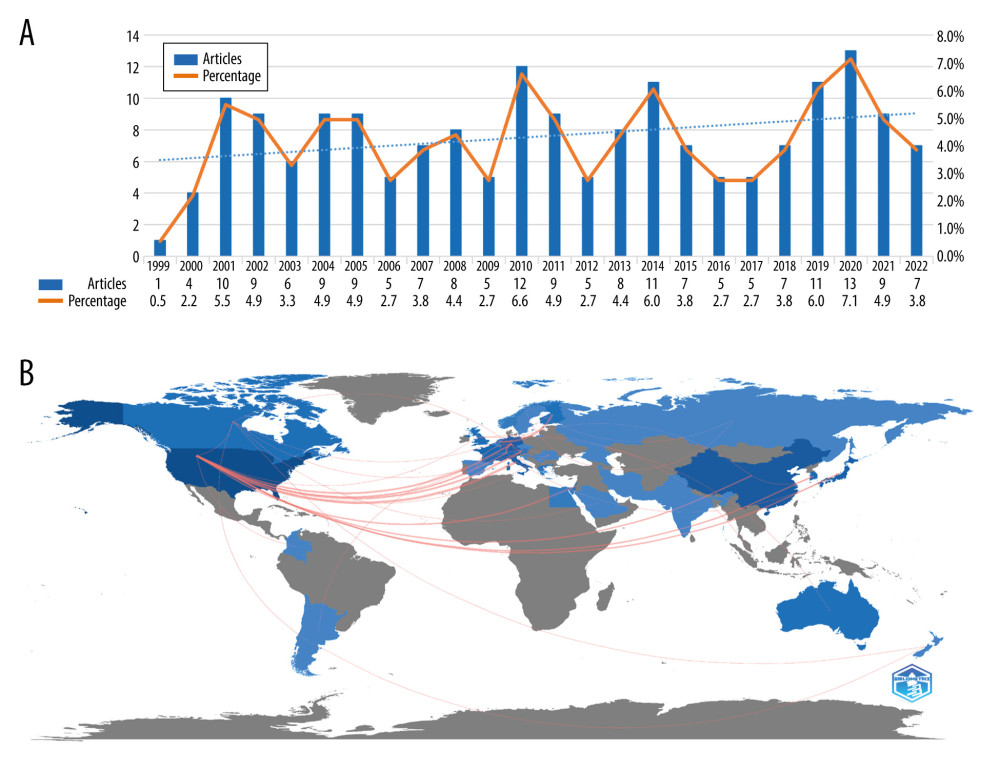 Figure 1. Annual publication and cooperation map using R package “bibliometrix”. (A) Trends in the number of publications. (B) The cooperation of countries contributing to publications.
Figure 1. Annual publication and cooperation map using R package “bibliometrix”. (A) Trends in the number of publications. (B) The cooperation of countries contributing to publications. 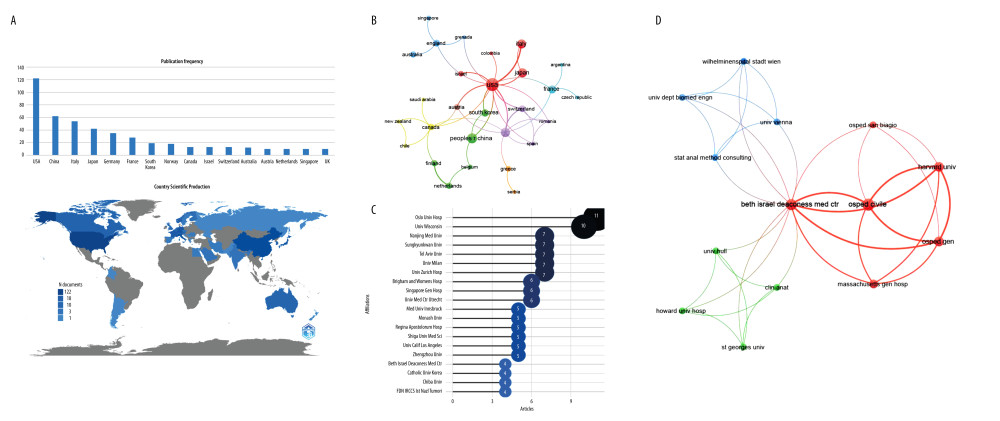 Figure 2. Analysis of top countries and relevant institutions that contributed to publications using R package “bibliometrix” and VOSviewer (1.6.18). (A) Bar plot showing top 20 countries and the publications map. (B) The visualized cooperation of countries. (C) Bar plot showing top 20 institutions. (D) A network map of institutions. MCP – multiple-country publications; SCP – single-country publications.
Figure 2. Analysis of top countries and relevant institutions that contributed to publications using R package “bibliometrix” and VOSviewer (1.6.18). (A) Bar plot showing top 20 countries and the publications map. (B) The visualized cooperation of countries. (C) Bar plot showing top 20 institutions. (D) A network map of institutions. MCP – multiple-country publications; SCP – single-country publications. 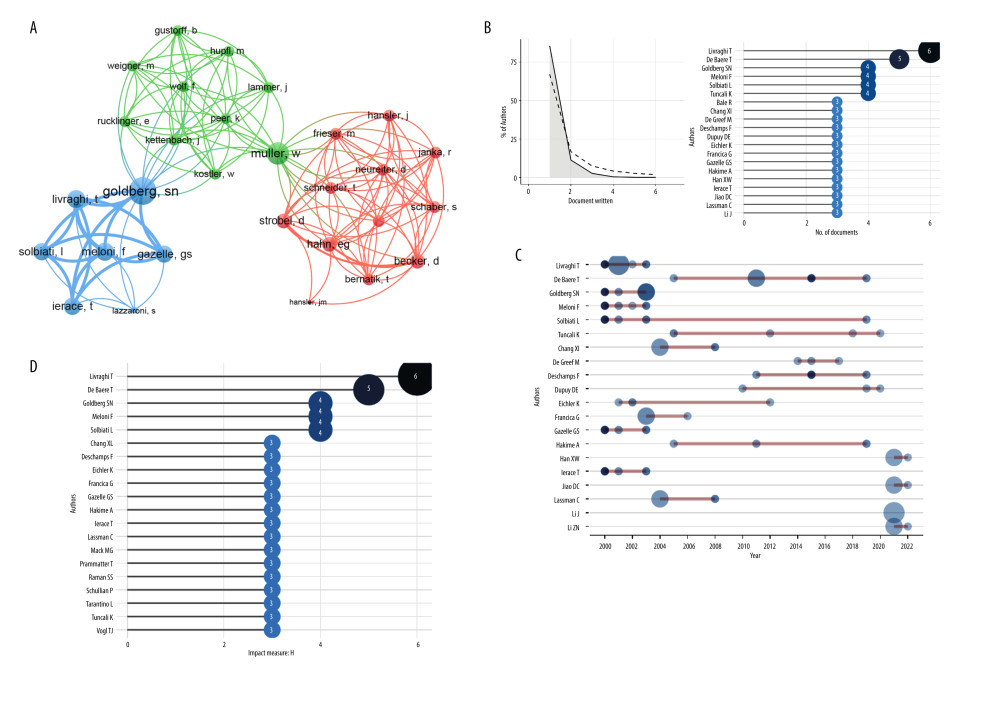 Figure 3. Results of core authors involved using VOSviewer (version 1.6.18) and the R package “bibliometrix”. (A) The cooperation between core authors. (B) The frequency distribution of scientific productivity and the top 20 authors in total publications. (C) Top authors’ production over time. The line represents an author’s timeline, and Solbiati L has the longest timeline, from 2000 to 2020. The color intensity is proportional to the total citations per year. The bubble size is proportional to the number of documents (Livraghi T in 2001 authored 3 documents and collected 8.5 total citations per year). (D) Top 20 authors in H-index.
Figure 3. Results of core authors involved using VOSviewer (version 1.6.18) and the R package “bibliometrix”. (A) The cooperation between core authors. (B) The frequency distribution of scientific productivity and the top 20 authors in total publications. (C) Top authors’ production over time. The line represents an author’s timeline, and Solbiati L has the longest timeline, from 2000 to 2020. The color intensity is proportional to the total citations per year. The bubble size is proportional to the number of documents (Livraghi T in 2001 authored 3 documents and collected 8.5 total citations per year). (D) Top 20 authors in H-index. 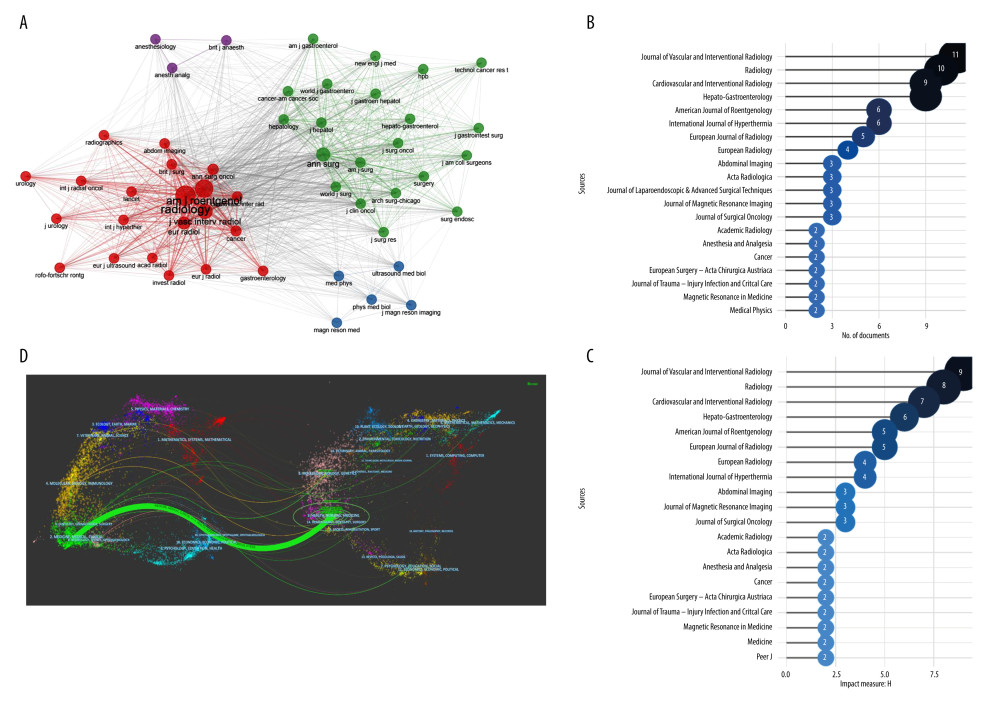 Figure 4. The results of the journals involved were obtained using R package “bibliometrix” and CiteSpace (version 5.7.R5). (A) Network map showing academic journals publishing research on anesthesia in relation to liver ablation. (B) The top 20 academic journals that contributed to publications. (C) The top 20 academic journals in H-index. (D) A dual-map overlay of journals related to the research.
Figure 4. The results of the journals involved were obtained using R package “bibliometrix” and CiteSpace (version 5.7.R5). (A) Network map showing academic journals publishing research on anesthesia in relation to liver ablation. (B) The top 20 academic journals that contributed to publications. (C) The top 20 academic journals in H-index. (D) A dual-map overlay of journals related to the research. 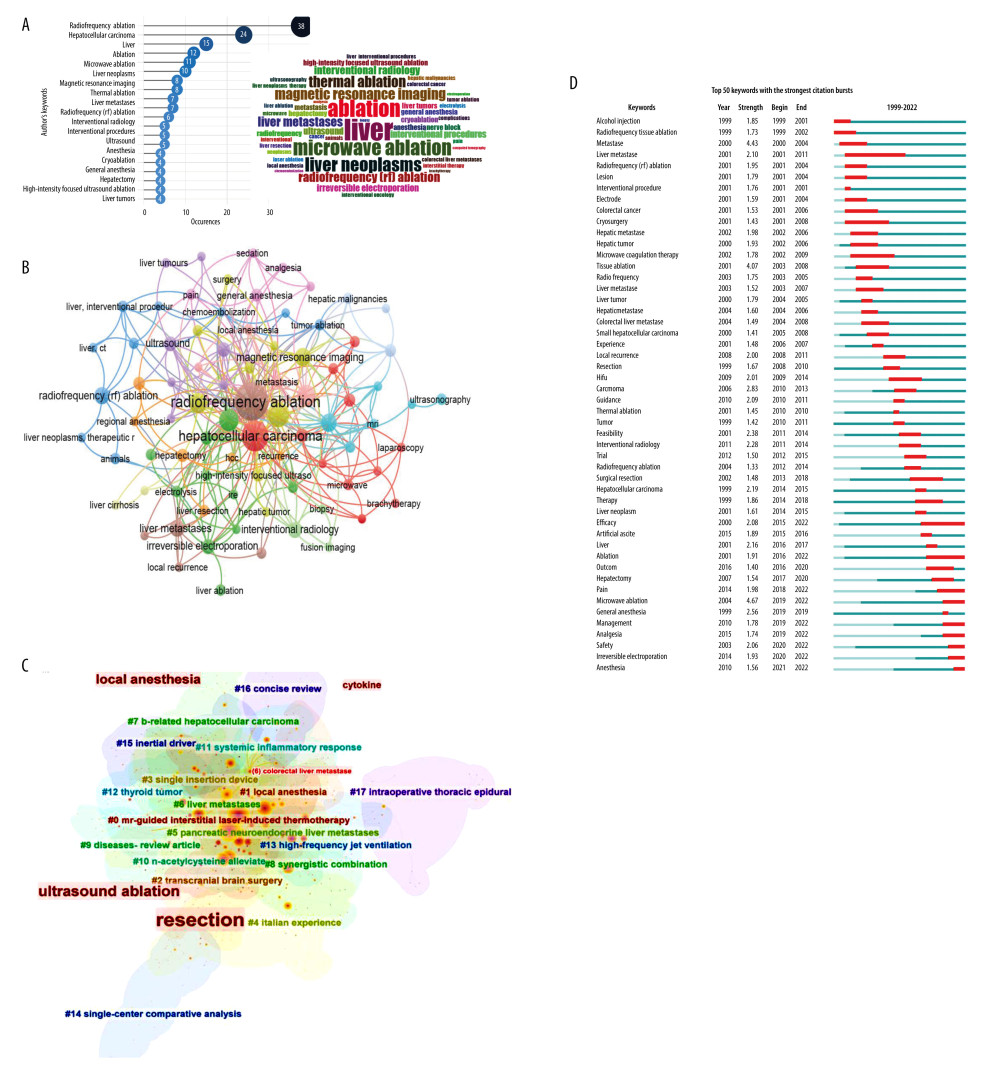 Figure 5. Keywords development results using R package “bibliometrix”, VOSviewer (1.6.18), and CiteSpace (5.7.R5). (A) Bar diagram and word cloud showing the top 20 keywords. (B) Network map of keywords. (C) Clusters of keywords. (D) The keywords with the strong citation bursts in articles related to anesthesia research in liver ablation.
Figure 5. Keywords development results using R package “bibliometrix”, VOSviewer (1.6.18), and CiteSpace (5.7.R5). (A) Bar diagram and word cloud showing the top 20 keywords. (B) Network map of keywords. (C) Clusters of keywords. (D) The keywords with the strong citation bursts in articles related to anesthesia research in liver ablation. References
1. Chen JG, Zhang SW, Liver cancer epidemic in China: Past, present and future: Semin Cancer Biol, 2011; 21(1); 59-69
2. Chen QF, Dai L, Wu Y, Surveillance strategy for barcelona clinic liver cancer B hepatocellular carcinoma achieving complete response: An individualized risk-based machine learning study: Front Bioeng Biotechnol, 2021; 9; 667641
3. Jin Q, Chen X, Zheng S, The security rating on local ablation and interventional therapy for hepatocellular carcinoma (HCC) and the comparison among multiple anesthesia methods: Anal Cell Pathol (Amsterdam), 2019; 2019; 2965173
4. Chen QF, Liu S, Lyu N, Surveillance strategy after complete ablation of initial recurrent hepatocellular carcinoma: A risk-based machine learning study: J Vasc Interv Radiol, 2021; 32(11); 1548-57e2
5. Chen MS, Li JQ, Zheng Y, A prospective randomized trial comparing percutaneous local ablative therapy and partial hepatectomy for small hepatocellular carcinoma: Ann Surg, 2006; 243(3); 321-28
6. Piccioni F, Poli A, Templeton LC, Anesthesia for percutaneous radiofrequency tumor ablation (PRFA): A review of current practice and techniques: Local Reg Anesth, 2019; 12; 127-37
7. Beermann M, Lindeberg J, Engstrand J, 1000 consecutive ablation sessions in the era of computer assisted image guidance – lessons learned: Eur J Radiol Open, 2019; 6; 1-8
8. Synnestvedt MB, Chen C, Holmes JH, CiteSpace II: Visualization and knowledge discovery in bibliographic databases: AMIA Annu Symp Proc, 2005; 2005; 724-28
9. Yeung AWK, Tzvetkov NT, Balacheva AA, Lignans: Quantitative analysis of the research literature: Front Pharmacol, 2020; 11; 37
10. Li C, Ojeda-Thies C, Renz N, Margaryan D, The global state of clinical research and trends in periprosthetic joint infection: A bibliometric analysis: Int J Infect Dis, 2020; 96; 696-709
11. Shen J, Shen H, Ke L, Knowledge mapping of immunotherapy for hepatocellular carcinoma: A bibliometric study: Front Immunol, 2022; 13; 815575
12. Eyre-Walker A, Stoletzki N, The assessment of science: The relative merits of post-publication review, the impact factor, and the number of citations: PLoS Biol, 2013; 11(10); e1001675
13. Xie L, Chen Z, Wang H, Bibliometric and visualized analysis of scientific publications on atlantoaxial spine surgery based on Web of Science and VOSviewer: World Neurosurg, 2020; 137; 435-42e4
14. Chen C, Hu Z, Liu S, Tseng H, Emerging trends in regenerative medicine: A scientometric analysis in CiteSpace: Expert Opin Biol Ther, 2012; 12(5); 593-608
15. Yao CL, Trinh T, Wong GT, Irwin MG, Anaesthesia for high intensity focused ultrasound (HIFU) therapy: Anaesthesia, 2008; 63(8); 865-72
16. Piccioni F, Fumagalli L, Garbagnati F, Thoracic paravertebral anesthesia for percutaneous radiofrequency ablation of hepatic tumors: J Clin Anesth, 2014; 26(4); 271-75
17. Davis CR, Interventional radiological treatment of hepatocellular carcinoma: Cancer Control, 2010; 17(2); 87-99
18. Allaf ME, Varkarakis IM, Bhayani SB, Pain control requirements for percutaneous ablation of renal tumors: Cryoablation versus radiofrequency ablation – initial observations: Radiology, 2005; 237(1); 366-70
19. Cannon R, Ellis S, Hayes D, Safety and early efficacy of irreversible electroporation for hepatic tumors in proximity to vital structures: J Surg Oncol, 2013; 107(5); 544-49
20. Bray F, Ferlay J, Soerjomataram I, Global cancer statistics 2018: GLOBOCAN estimates of incidence and mortality worldwide for 36 cancers in 185 countries: Cancer J Clin, 2018; 68(6); 394-424
21. Goldberg SN, Grassi CJ, Cardella JF, Image-guided tumor ablation: Standardization of terminology and reporting criteria: Radiology, 2005; 235(3); 728-39
22. Ahmed M, Solbiati L, Brace CL, Image-guided tumor ablation: Standardization of terminology and reporting criteria – a 10-year update: Radiology, 2014; 273(1); 241-60
23. Bai XM, Cui M, Yang W, The 10-year survival analysis of radiofrequency ablation for solitary hepatocellular carcinoma 5 cm or smaller: Primary versus recurrent HCC: Radiology, 2021; 300(2); 458-69
24. Puijk RS, Ahmed M, Adam A, Consensus guidelines for the definition of time-to-event end points in image-guided tumor ablation: Results of the SIO and DATECANiInitiative: Radiology, 2021; 301(3); 533-40
25. Sze DY, Progress accelerated: J Vasc Interv Radiol, 2021; 32(5); 641-42
26. Moy L, Editor’s note: January 2023: Radiology, 2023; 306(1); 1-3
27. Tashi S, Chandramohan S, Adam A, Tan BS, Accreditation in interventional radiology: Why it matters and why we sought IASIOS certification: Cardiovasc Interv Radiol, 2022; 45(12); 1763-64
28. Tan L, Wang X, Yuan K, Structural and temporal dynamics analysis on drug-eluting stents: History, research hotspots and emerging trends: Bioact Mater, 2023; 23; 170-86
29. Sofyantoro F, Frediansyah A, Priyono DS, Growth in chikungunya virus-related research in ASEAN and South Asian countries from 1967 to 2022 following disease emergence: A bibliometric and graphical analysis: Glob Health, 2023; 19(1); 9
Figures
 Figure 1. Annual publication and cooperation map using R package “bibliometrix”. (A) Trends in the number of publications. (B) The cooperation of countries contributing to publications.
Figure 1. Annual publication and cooperation map using R package “bibliometrix”. (A) Trends in the number of publications. (B) The cooperation of countries contributing to publications. Figure 2. Analysis of top countries and relevant institutions that contributed to publications using R package “bibliometrix” and VOSviewer (1.6.18). (A) Bar plot showing top 20 countries and the publications map. (B) The visualized cooperation of countries. (C) Bar plot showing top 20 institutions. (D) A network map of institutions. MCP – multiple-country publications; SCP – single-country publications.
Figure 2. Analysis of top countries and relevant institutions that contributed to publications using R package “bibliometrix” and VOSviewer (1.6.18). (A) Bar plot showing top 20 countries and the publications map. (B) The visualized cooperation of countries. (C) Bar plot showing top 20 institutions. (D) A network map of institutions. MCP – multiple-country publications; SCP – single-country publications. Figure 3. Results of core authors involved using VOSviewer (version 1.6.18) and the R package “bibliometrix”. (A) The cooperation between core authors. (B) The frequency distribution of scientific productivity and the top 20 authors in total publications. (C) Top authors’ production over time. The line represents an author’s timeline, and Solbiati L has the longest timeline, from 2000 to 2020. The color intensity is proportional to the total citations per year. The bubble size is proportional to the number of documents (Livraghi T in 2001 authored 3 documents and collected 8.5 total citations per year). (D) Top 20 authors in H-index.
Figure 3. Results of core authors involved using VOSviewer (version 1.6.18) and the R package “bibliometrix”. (A) The cooperation between core authors. (B) The frequency distribution of scientific productivity and the top 20 authors in total publications. (C) Top authors’ production over time. The line represents an author’s timeline, and Solbiati L has the longest timeline, from 2000 to 2020. The color intensity is proportional to the total citations per year. The bubble size is proportional to the number of documents (Livraghi T in 2001 authored 3 documents and collected 8.5 total citations per year). (D) Top 20 authors in H-index. Figure 4. The results of the journals involved were obtained using R package “bibliometrix” and CiteSpace (version 5.7.R5). (A) Network map showing academic journals publishing research on anesthesia in relation to liver ablation. (B) The top 20 academic journals that contributed to publications. (C) The top 20 academic journals in H-index. (D) A dual-map overlay of journals related to the research.
Figure 4. The results of the journals involved were obtained using R package “bibliometrix” and CiteSpace (version 5.7.R5). (A) Network map showing academic journals publishing research on anesthesia in relation to liver ablation. (B) The top 20 academic journals that contributed to publications. (C) The top 20 academic journals in H-index. (D) A dual-map overlay of journals related to the research. Figure 5. Keywords development results using R package “bibliometrix”, VOSviewer (1.6.18), and CiteSpace (5.7.R5). (A) Bar diagram and word cloud showing the top 20 keywords. (B) Network map of keywords. (C) Clusters of keywords. (D) The keywords with the strong citation bursts in articles related to anesthesia research in liver ablation.
Figure 5. Keywords development results using R package “bibliometrix”, VOSviewer (1.6.18), and CiteSpace (5.7.R5). (A) Bar diagram and word cloud showing the top 20 keywords. (B) Network map of keywords. (C) Clusters of keywords. (D) The keywords with the strong citation bursts in articles related to anesthesia research in liver ablation. In Press
11 Mar 2024 : Clinical Research
Comparison of Effects of Sugammadex and Neostigmine on Postoperative Neuromuscular Blockade Recovery in Pat...Med Sci Monit In Press; DOI: 10.12659/MSM.942773
12 Mar 2024 : Clinical Research
Comparing Neuromuscular Blockade Measurement Between Upper Arm (TOF Cuff®) and Eyelid (TOF Scan®) Using Miv...Med Sci Monit In Press; DOI: 10.12659/MSM.943630
11 Mar 2024 : Clinical Research
Enhancement of Frozen-Thawed Human Sperm Quality with Zinc as a Cryoprotective AdditiveMed Sci Monit In Press; DOI: 10.12659/MSM.942946
12 Mar 2024 : Database Analysis
Risk Factors of Age-Related Macular Degeneration in a Population-Based Study: Results from SHIP-TREND-1 (St...Med Sci Monit In Press; DOI: 10.12659/MSM.943140
Most Viewed Current Articles
17 Jan 2024 : Review article
Vaccination Guidelines for Pregnant Women: Addressing COVID-19 and the Omicron VariantDOI :10.12659/MSM.942799
Med Sci Monit 2024; 30:e942799
14 Dec 2022 : Clinical Research
Prevalence and Variability of Allergen-Specific Immunoglobulin E in Patients with Elevated Tryptase LevelsDOI :10.12659/MSM.937990
Med Sci Monit 2022; 28:e937990
16 May 2023 : Clinical Research
Electrophysiological Testing for an Auditory Processing Disorder and Reading Performance in 54 School Stude...DOI :10.12659/MSM.940387
Med Sci Monit 2023; 29:e940387
01 Jan 2022 : Editorial
Editorial: Current Status of Oral Antiviral Drug Treatments for SARS-CoV-2 Infection in Non-Hospitalized Pa...DOI :10.12659/MSM.935952
Med Sci Monit 2022; 28:e935952









